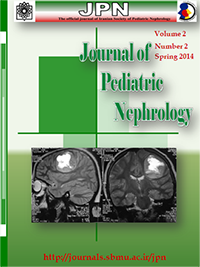Introduction: Early rehydration with bolus fluid can be life saving. We compared isotonic saline with a hypotonic fluid which was composed of saline 0.9%, dextrose, and bicarbonate in our clinical setting.
Materials and Methods: 71 children entered to this study , 41 cases received isotonic saline and the remaining 30 cases received hypotonic fluid which was composed of 750 cc saline 0.9%, 28 cc bicarbonate 7.5%, and 222cc dextrose 5% for resuscitation fluid challenge at a dose of 20ml/kg over 20 minutes that could be repeated up to 3 times as needed. Serum sodium (Na), potassium (K), blood sugar (BS) and bicarbonate (HCo3) were measured before initiating rehydration and after 3 hours. T independent test was used to compare the values between the two groups and T paired test in each group in SPSS 16. The level of significance was set at 0.05.
Results: Serum Na, K, BS, and HCo3 were 134±5, 3.8 ±0.6, 90±16, and 11.6±3.6 before and 135±4, 3.7±0.5, 73±13, and 15±3 three hours after rehydration in the isotonic group, respectively.
In the isotonic rehydrated group, BS drop and HCo3 rise significantly (p<0.001). Serum Na, K, BS, and HCo3 were 134±6, 3.6±0.6, 91±15, and 10.1±1.9 before and 136±3, 3.6±0.4, 94±10, and 15±2 three hours after rehydration in the hypotonic saline group, respectively. Serum sodium increased 2meq/dl (p<0.04) and bicarbonate increased 4.9 meq/l (P< 0.001).
Conclusions: The hypotonic serum containing 115meq/l of sodium chloride combined with 25meq/l of sodium bicarbonate and dextrose 1.1% is not associated with a decrease in BS or hyponatremia. It also increases serum HCo3 prominently.
Keywords: Hypotonic Solutions; Isotonic Solutions; Dehydration; Child.

